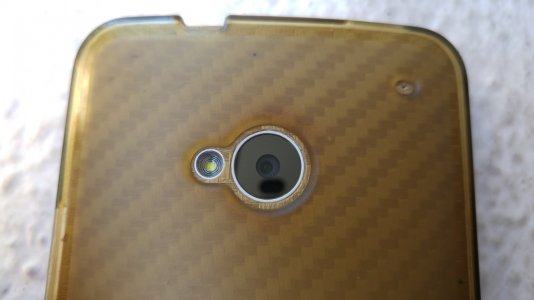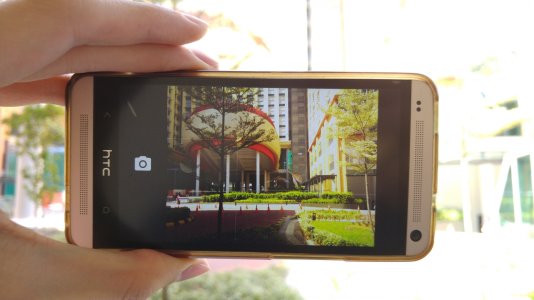- Sep 4, 2013
- 4,407
- 0
- 0
I wonder if anyone still remembers the HTC UltraPixel gamble.
You know, the main camera on the One M7 + M8 and the front-shooter on the M9. Remember when HTC didn't want to take part in the megapixel race and instead, focused on a 2-micron pixel size for the best possible low-light photos?
Well, with HTC using a 20-megapixel Toshiba T4KA7 sensor on the M9 as the main camera, is the UltraPixel still a good idea?
Me? Sounds crazy but.....yes, I still think it was a great idea, in theory.

Let me explain. Phone camera sensors are typically very small, and cramming tons of pixels inside one can have some issues, especially in low-light, where individual pixels are too small to receive sufficient light. This can be mitigated by using a larger sensor, adding OIS and a wider aperture, like on the LG G4. However, HTC didn't want to join the MP race and instead, wanted to attempt to innovate and create a camera sensor that provides good low-light shots but also having pretty decent daylight shots. Hence, why the UltraPixel was born.
A great concept in theory, but why is it frowned upon? 4 megapixels.
HTC chose the 4MP sensor resolution because on the size of the sensor they were using, 4MP gave them pixels the size of 2 microns. Of course, in theory, 4MP would be adequate since it's bigger than what people share online, which is what most people do with their smartphone's photos anyway. However, the execution kinda fell flat as the dynamic range isn't as high as we would hope and due to the sensor's Bayer layout, effective resolution was actually at a paltry 2MP instead of 4MP, which explains the lack of detail in daylight shots, although it's still detailed enough for pictures of cats for your Instagram collection.

Okay, so if I think that their execution fell flat on its face, why do I still think it's a great idea? Because when done right, it can produce great results.
The iPhone 6's camera is pretty much the descendant of the UltraPixel. Instead of favoring large pixel counts, it focuses on individual pixel size with 1.5-micron pixels on an 8MP custom Sony Exmor RS sensor. The higher resolution means that daylight shots are more detailed, while having a pixel-size large enough so that low-light shots look decent. If anything, the pictures on Apple's "Shot on iPhone 6" gallery seem to be a pretty good look at the capabilities of its camera.
Simply put, the UltraPixel is a great idea, and if done right, can produce pretty good results. But I think HTC's execution could have been a little bit better, but since the M8's camera wasn't a complete potato, it wasn't a terrible camera. It was actually decent. Though, considering HTC's falling fortunes, my expectations are probably too high.
You know, the main camera on the One M7 + M8 and the front-shooter on the M9. Remember when HTC didn't want to take part in the megapixel race and instead, focused on a 2-micron pixel size for the best possible low-light photos?
Well, with HTC using a 20-megapixel Toshiba T4KA7 sensor on the M9 as the main camera, is the UltraPixel still a good idea?
Me? Sounds crazy but.....yes, I still think it was a great idea, in theory.

Let me explain. Phone camera sensors are typically very small, and cramming tons of pixels inside one can have some issues, especially in low-light, where individual pixels are too small to receive sufficient light. This can be mitigated by using a larger sensor, adding OIS and a wider aperture, like on the LG G4. However, HTC didn't want to join the MP race and instead, wanted to attempt to innovate and create a camera sensor that provides good low-light shots but also having pretty decent daylight shots. Hence, why the UltraPixel was born.
A great concept in theory, but why is it frowned upon? 4 megapixels.
HTC chose the 4MP sensor resolution because on the size of the sensor they were using, 4MP gave them pixels the size of 2 microns. Of course, in theory, 4MP would be adequate since it's bigger than what people share online, which is what most people do with their smartphone's photos anyway. However, the execution kinda fell flat as the dynamic range isn't as high as we would hope and due to the sensor's Bayer layout, effective resolution was actually at a paltry 2MP instead of 4MP, which explains the lack of detail in daylight shots, although it's still detailed enough for pictures of cats for your Instagram collection.

Okay, so if I think that their execution fell flat on its face, why do I still think it's a great idea? Because when done right, it can produce great results.
The iPhone 6's camera is pretty much the descendant of the UltraPixel. Instead of favoring large pixel counts, it focuses on individual pixel size with 1.5-micron pixels on an 8MP custom Sony Exmor RS sensor. The higher resolution means that daylight shots are more detailed, while having a pixel-size large enough so that low-light shots look decent. If anything, the pictures on Apple's "Shot on iPhone 6" gallery seem to be a pretty good look at the capabilities of its camera.
Simply put, the UltraPixel is a great idea, and if done right, can produce pretty good results. But I think HTC's execution could have been a little bit better, but since the M8's camera wasn't a complete potato, it wasn't a terrible camera. It was actually decent. Though, considering HTC's falling fortunes, my expectations are probably too high.
Last edited:

